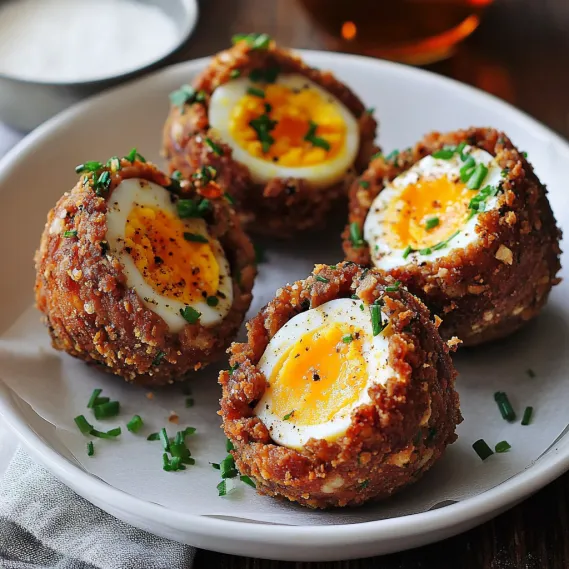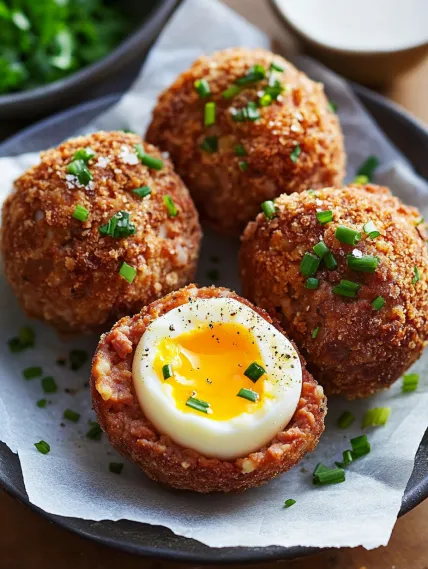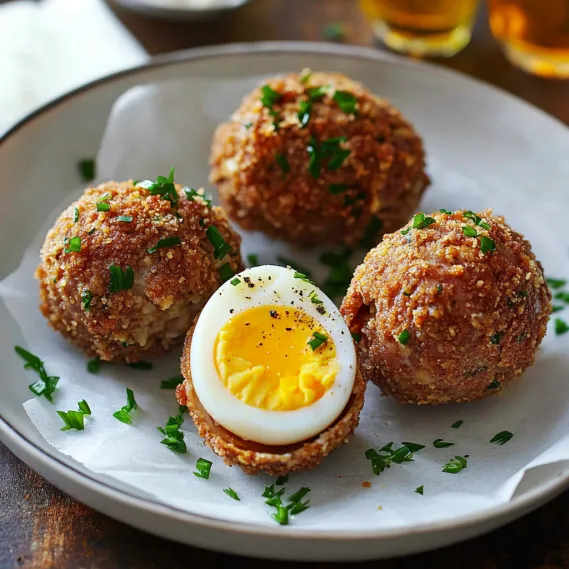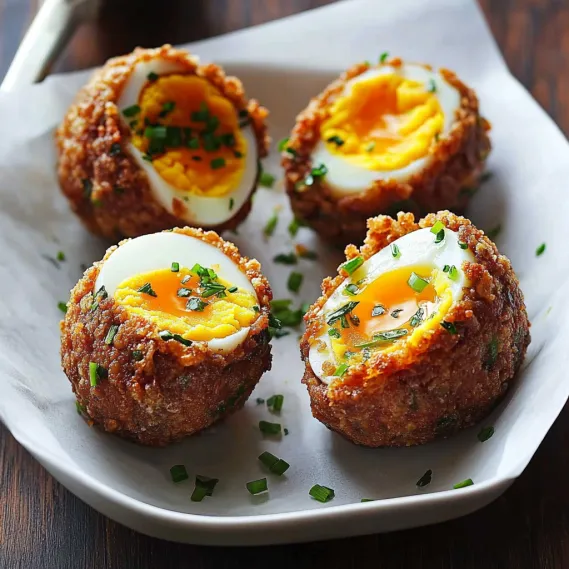 Pin it
Pin it
When you take that first bite of a hot Scotch Egg, you're hit with an amazing mix of textures – that satisfying snap of crispy panko breaks into a juicy layer of seasoned sausage, finally revealing the hidden gem inside: that perfectly cooked egg with its dreamy, soft center.
I brought these to a family party last week, and my super-picky nephew who normally only eats chicken nuggets wolfed down two of them back-to-back. What's the trick? Taking time with each part, especially getting that soft-boiled egg just right to create that wow moment when you cut it open.
Key Components and Shopping Advice
- Eggs: Go for large eggs that aren't super fresh. Eggs about a week old actually peel much easier after boiling than ones straight from the chicken.
- Breakfast Sausage: Grab top-notch pork sausage with bits of herbs you can see and enough fat to keep things tasty.
- Panko Breadcrumbs: These Japanese breadcrumbs give you a much airier, crunchier coating than regular breadcrumbs ever could.
- Fresh Herbs: Don't try to skip the fresh chives and parsley – they really wake up the sausage mix and add layers of flavor.
- English Mustard: This adds a nice kick and depth to your sausage. If you can't find it, Dijon works fine too.
I've learned that your sausage quality really makes or breaks the whole dish. When I can, I get mine from my neighborhood butcher where I know it'll have just the right mix of meat, fat, and spices for that perfect flavor and juicy texture.
Step-by-Step Preparation Guide
- Step 1: Cook Your Eggs Just Right
- Get a medium pot with enough cold water to cover 4 large eggs by about an inch. Let it come to a full boil, turn down the heat slightly, and time it for exactly 6 minutes for soft centers or 7 minutes if you want them a bit firmer. Right away, dump them in ice water for 10 minutes to stop them cooking, then carefully peel them under running water.
- Step 2: Mix Up Your Tasty Sausage Blend
- In a bowl, mix 1 pound of breakfast sausage with 2 tablespoons each of finely chopped fresh chives and parsley. Toss in 1 tablespoon of English mustard, ¼ teaspoon of freshly grated nutmeg, ½ teaspoon of salt, and ¼ teaspoon of black pepper. Mix it all together with your hands until everything's evenly spread out.
- Step 3: Get Your Coating Station Ready
- Set up three shallow dishes: first one with ½ cup all-purpose flour and a pinch of salt; second with 2 eggs beaten with 1 tablespoon of water; and third with 2 cups of panko breadcrumbs. Keep one hand for dry stuff and one for wet stuff so you don't end up with goopy fingers.
- Step 4: Wrap Those Eggs Like a Pro
- Split the sausage mix into 4 equal chunks. With slightly wet hands, flatten each piece into an oval about ¼-inch thick. Put a peeled egg in the middle of each oval, then carefully wrap the sausage around it, smoothing and pinching the edges to seal it up completely.
- Step 5: Do the Double-Coat Method
- Take each sausage-wrapped egg, roll it first in the flour and tap off extra, then dunk it in beaten egg letting extra drip off, and finally roll in panko, pressing gently so it sticks well.
 Pin it
Pin it
The first time I tried making these, I was scared of the wrapping part. After a few wonky attempts, I figured out that it doesn't matter if they look perfect - they still taste amazing either way. Now my kids help fold them, each with their own special style that's become part of how we make them as a family.
Achieving Incredible Texture Balance
What makes these treats so special is how they mix different textures - crunchy bottoms with soft, flavorful fillings. I've found that managing moisture is the trick. First, you gotta really squeeze that salted cabbage to get rid of water that would make everything mushy. Then, the cornstarch doesn't just hold stuff together - it soaks up any leftover wetness. Finally, the cooking method - fry, then steam, then fry again - gives you that awesome crispy bottom while making sure the filling cooks all the way through.
 Pin it
Pin it
Prep Ahead for Stress-Free Parties
The best thing about this dish is how you can make it ahead of time. When I'm having people over, I often do it in stages: shape and freeze the balls up to a month early, add the breadcrumbs the day before (keeping them covered in the fridge), and just bake them right before guests show up. The smell of them cooking fills the house with this amazing aroma that gets everyone hungry. For bigger gatherings, I make two batches, keeping the second one warm in a low-temp oven until needed.
Creative Ways to Use Extras
If you somehow end up with leftover Scotch eggs (which hardly ever happens at my place!), you can turn them into completely different meals. Break them up into some scrambled eggs for a French-style breakfast hash, or cut them into slices on a green salad with spicy dressing for a quick lunch. My favorite trick is to put halved Scotch eggs on top of some creamy grits, making a filling breakfast that carries the flavors into the next day.
 Pin it
Pin it
Pro Kitchen Shortcuts
- Let the balls cool down for 5 minutes after cooking before you dig in – this helps everything set up for that perfect bite
- For extra flavor kick, mix a teaspoon of smoked paprika into your panko
- Can't find good Scotch eggs nearby? Order them online from places like Bourgeois Meat Market or The Best Stop
- Put out several dipping options – spicy remoulade and cool ranch along with that Louisiana sauce
- For a party-ready look, put the balls on a platter with sprinkles of chopped parsley, purple cabbage, and yellow bell pepper to show off the traditional green, purple, and gold colors
Frequently Asked Questions
- → Is it possible to bake Scotch eggs instead?
- Yes! Baking is an option, but they won’t be as crunchy as frying. To bake, heat up your oven to 400°F (200°C), place the eggs on baking paper, lightly coat with oil, and bake for 25-30 minutes, flipping halfway. Make sure the sausage hits 145°F when done.
- → What kind of sausage works well here?
- Plain pork sausage is a go-to for traditional flavor, but breakfast sausage works as it’s pre-seasoned. Feel free to try Italian, chorizo, or even ground turkey if you prefer. Adjust any spices to match the level of seasoning already in your sausage.
- → Can I prep these ahead for guests?
- You sure can! Make them up to two days early and store in your fridge. Serve chilled like a picnic classic or warm them back up in a 350°F (175°C) oven for about 10-15 minutes. Just don’t overdo it, as reheating too much might dry them out.
- → How do I get that gooey yolk texture?
- For a perfect jammy center, timing is essential. Start with cold eggs from the fridge, place them in cool water, then boil. Cook for 4 minutes once it comes to a rolling boil and plunge them straight into ice water to keep the yolk dreamy inside.
- → What’s a good side for these treats?
- Scotch eggs go great with tangy mustard, pickles, or some piccalilli. Try adding a fresh salad, pickled veggies, or crispy fries if you’re making them into a full meal. They’re also great with crusty bread and cheese for a hearty platter.
- → Why does my sausage crust crack when cooking?
- Cracks usually happen if the sausage is unevenly spread or the seams aren’t sealed tightly. Make the layer uniform, press seams firmly, and fry at around 325°F. Also, let a crust form before moving them to avoid splitting.
